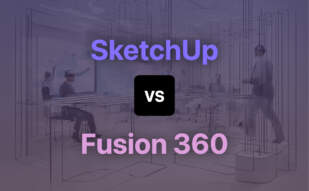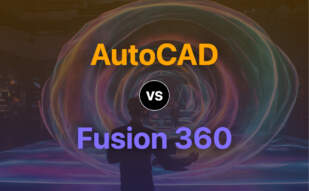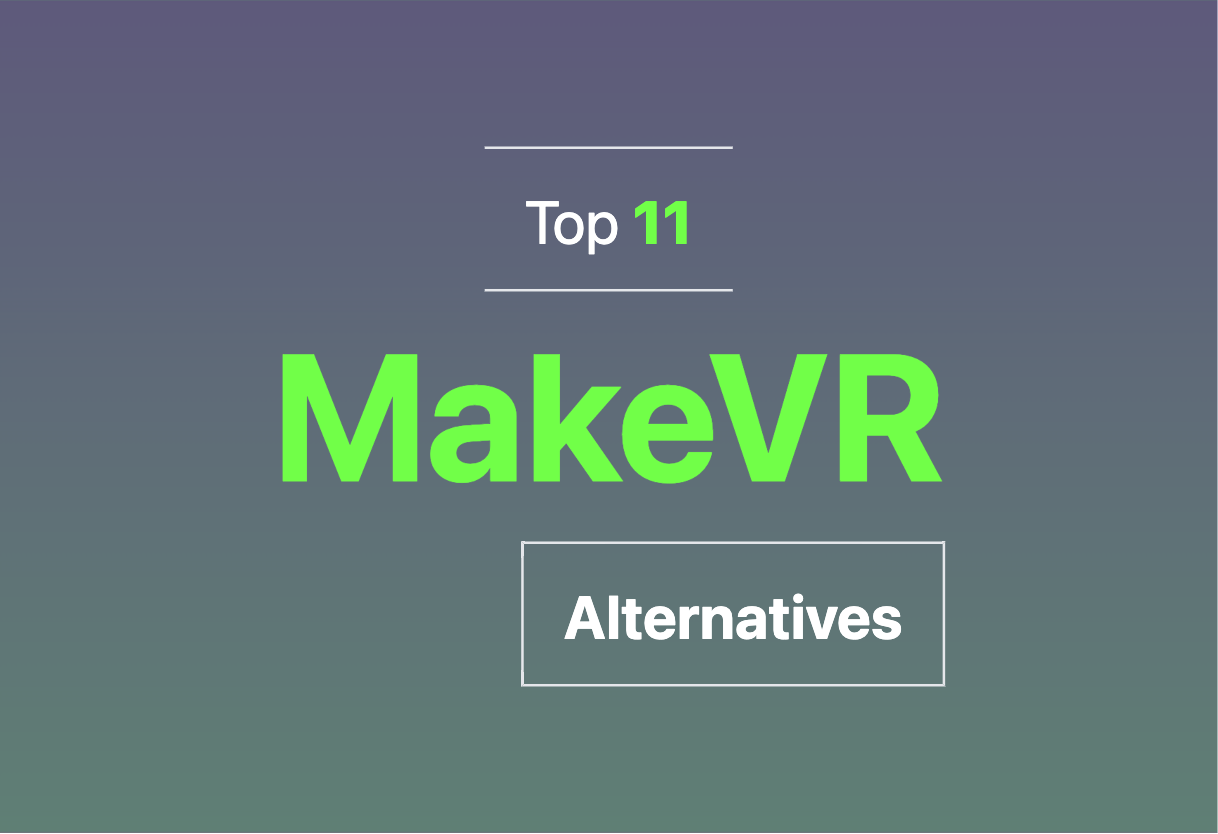
Fusion 360
Developed by leading software company, Autodesk, Fusion 360 is an integrated platform designed for design, engineering, electronics, and manufacturing. With its first release in 2013, Fusion 360 provides a comprehensive solution for CAD, CAM, CAE, and PCB design supported by various operating systems like Windows, macOS, Android, and iOS.
Fusion 360 Top Features
- Streamlined workflow offered by cloud integration.
- Expansive range of 2D & 3D designing capabilities and PCB layouts.
- Availability of functions like realistic rendering, cooling of electronics, and topology shape optimisation.
- Notable dedication to customer support, with strong learning resources and a large online community for support and regular feature updates.
| Features | Description |
|---|---|
| Multilingual Support | Fusion 360 supports multiple languages, offering a wider reach for its users. |
| Affordability | At relatively competitive prices, Fusion 360 is a popular choice among Small and Medium Enterprises (SMEs). |
| Integrated Software | With integrated electronics for MCAD and ECAD co-designing, Fusion 360 provides a seamless and user-friendly experience. |
Fusion 360 Disadvantages
- Despite its user-friendly interface, Fusion 360 lacks personal keyboard controls.
- Another limitation is the absence of a web-based standalone version.
- Potential malware risks have been reported, which is a concern for many users.
Fusion 360 Pricing
Fusion 360 is affordable with an annual subscription of $545/year or a scaled down option at $70/month. A limited, free version is also available for home use.
Fusion 360 Use Cases
Use case 1
Fusion 360 is extensively used in the field of mechanical engineering. With its advanced design and simulation capabilities, it fast-tracks the time between concept and product launch.
Use case 2
Professionals in aesthetic design and architecture can leverage Fusion 360’s realistic rendering functionalities to bring their concepts to life.
Use case 3
In electronics, Fusion 360’s integrated PCB design and simulation tools enable smooth prototyping and validation.
SketchUp
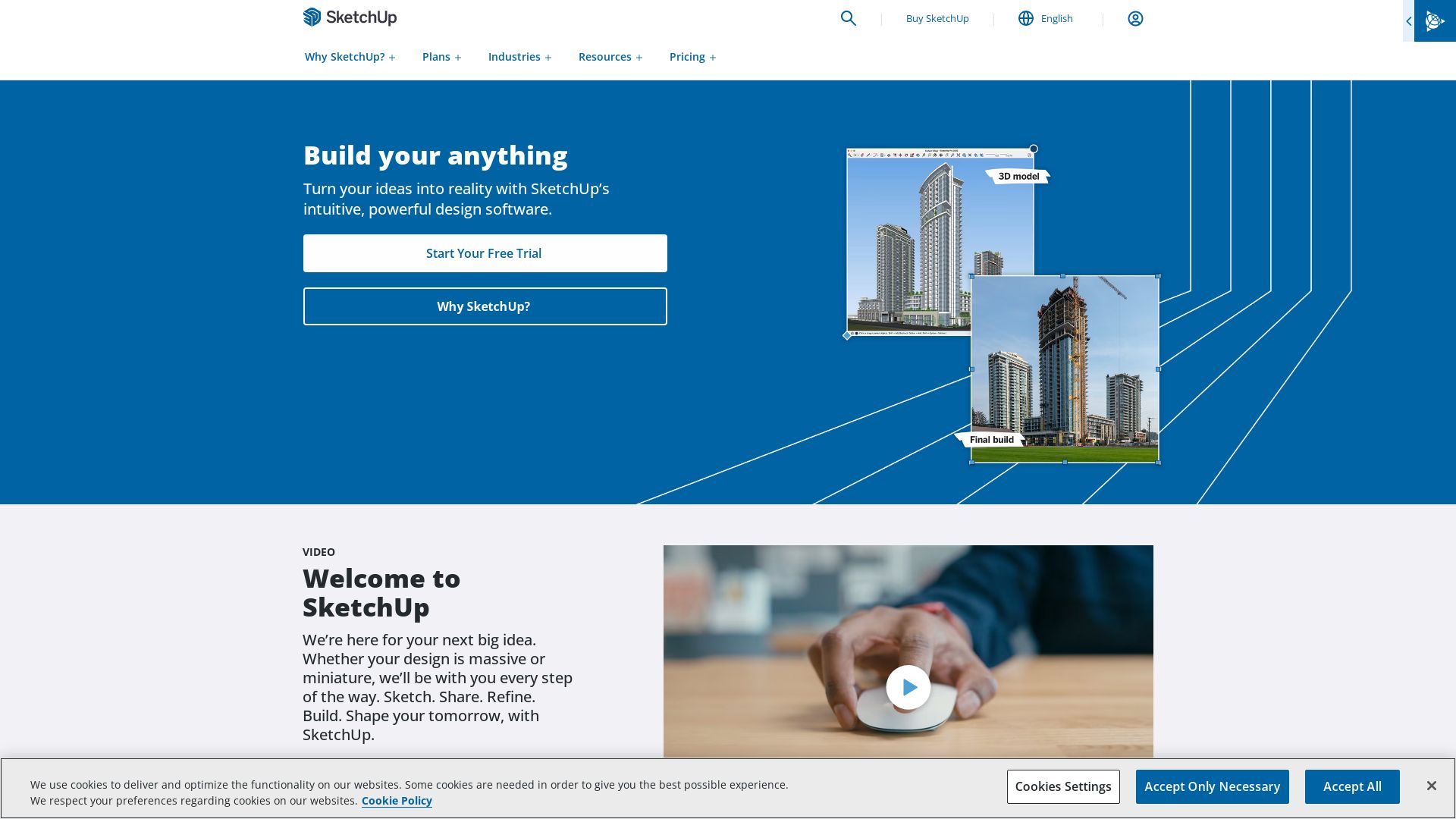
SketchUp is a versatile 3D modeling CAD program, developed by Trimble Inc. Renowned in the field, it graces diverse disciplines including architecture, interior design, industrial product design, and video game development.
SketchUp Top Features
- Architectural modeling to product visualization.
- Smart Drawing Tools.
- Extensive 3D Warehouse.
- Real-time collaboration.
- Impressive Rendering Options.
- Compatibility with V-Ray for photorealistic renders.
| NURBS Modeling | Known for precision, Rhino 3D integration brings accuracy to the creation process. |
| Chaos Enscape Integration | Global illumination made easy with one-click VR, material and lighting editor options. |
| File Support | SketchUp supports various 3D modeling formats including .3DS, .DAE, .DEM, .DDF, .DXF, .DWG, .IFC (.IFCZIP), .KMZ, .STL, and PDF (Mac Only). |
SketchUp Limitations
- Extensions are not supported in the free, web-based version.
- Switched to a subscription-based model as of November 2020 limiting the access to features.
SketchUp Use Cases
Use Case 1: Architecture
With its intuitive interface, SketchUp provides beginners and pros alike an innovative platform to bring their designs to life. Push/Pull technology, a patented feature, eases the modeling process significantly.
Use Case 2: Product Design
Incorporation of Rhino 3D improves precision anywhere from creating rough sketches to developing full-fledged product designs, often used in industrial work.
Use Case 3: Video Game Development
Real-time collaboration, made possible by SketchUp, allows game developers to work in sync. With advanced rendering options and 3D printing capabilities, visualizing games becomes more streamlined.
Juicer
If top-notch juicing is what you’re looking for, Juicer is a force to reckon with. Known for producing fresh, highly nutritious juice, it boasts impressive features like two models: the masticating and centrifugal, to cater to a plethora of juicing needs.
Juicer Top Features
- Masticating model: Slow, high-yield, quieter, and smaller with low foam generation.
- Centrifugal model: Fast and bulky with a low-yield and foam creation.
- Nama J2 Cold Press stands as the best overall dismantling skin, pulp, and pips efficiently while allowing large fruit and vegetable inputs.
- Omega H3000D, construes the best value for money delivering consistent nutritious juice output.
- NutriBullet Juicer Pro lives up to its name with easy usability and speedy operation.
| Prep Work | Dependent on the machine feed tube size, juicing simplifies with apt preparation. |
| Nutrient Claims | Acceleration up to 2000 rpm offers high nutrient levels and minimal waste. |
| Machine Noise | Silent operation as a result of excellent design and build quality. |
| Cleaning and Storage | Simple disassembly allows for easy cleaning, and the compact design makes storage hassle-free. |
Juicer Disadvantages
- Given the high yield, the output juice is tall and heavy, which may not suit everyone’s preference.
- The centrifugal model is loud and bulky, reducing portability and convenience.
Juicer Use Cases
Use case 1
For those focused on health and longevity, Juicer is an apt choice enhancing your juicing practice with high juice yield and low foam.
Use case 2
With its efficiency in juicing soft fruit and leafy vegetables, it serves as a boon for the daily consumption of fresh, nutritious juice.
Use case 3
For large scale juicing operations, the investment in a Juicer is justified by the speed, ease of use, and yield of high-quality juice.
SketchUp Pro
An ingenious creation brought to life by Trimble Inc., SketchUp Pro is a resourceful 3D computer graphics CAD application. Initially released by @Last software and later brought under the umbrella of Google, this software platform now stands as a powerhouse in various industry verticals since its inception in 2000.
SketchUp Pro Top Features
- Powerful drawing layout
- Surface rendering in a multitude of styles
- Model placement in Google Earth
- Access to a range of SketchUp’s model library and extension library
- Patented “Push/Pull” technology (U.S. Patent 6,628,279, 2003 – 2021)
| Extensions Support | Import/Export Files |
|---|---|
| Support from SketchUp 4 onward through Ruby-based extensions. | Supports a variety of file formats including SKP, BMP, GIF, JPEG, JPG, PNG, TIF, TIFF, RTF, TXT, DWG, and DXF. |
| Availability on the Trimble Extension Warehouse. | Export in PNG, JPG, PDF, DWG, and DXF formats. |
SketchUp Pro Limitations
- Transition to subscription model as of June 4, 2020
- PDF file format only supported for Mac users
SketchUp Pro Use Cases
Use Case 1: Architecture & Interior Design
Given its robust drawing layout capabilities and diverse style renderings, SketchUp Pro proves to be indispensable for architectural and interior design projects.
Use Case 2: Industrial/Product Design
With omnipotent model placement in Google Earth coupled with the powerful patented ‘Push/Pull’ technology, map out every minute design intricacy for industrial and product design.
Use Case 3: Civil/Mechanical Engineering
Long gone are the days of weary drafts and blueprints. Leverage SketchUp Pro’s superior CAD application, rendering it a preferred tool for civil and mechanical engineering.
Blender
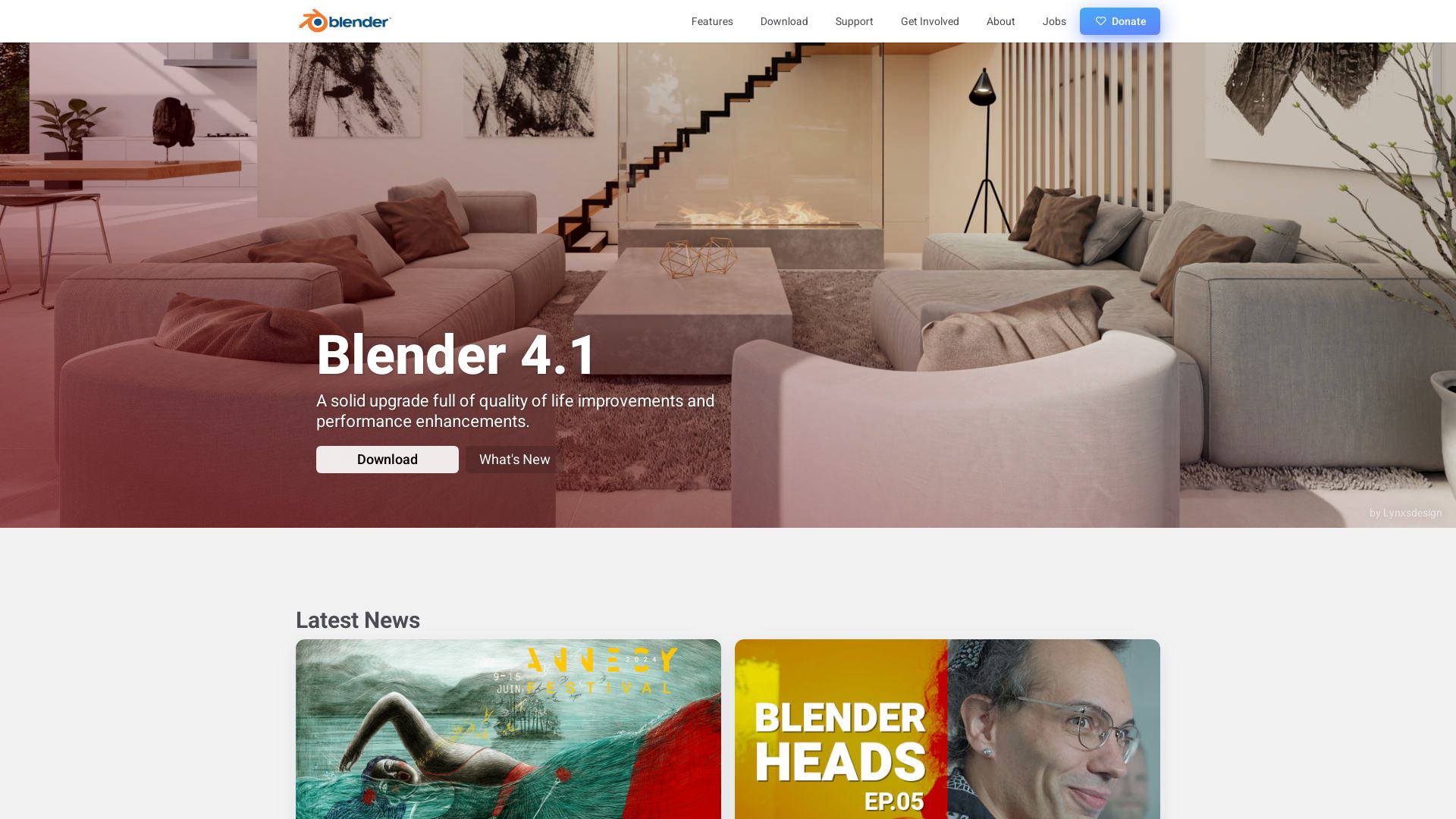
An impressive arsenal in the realm of 3D computer graphics, Blender is a free, open-source software tool set. Its wide-ranging applications extend from creating animated films and visual effects to 3D-printed models and virtual reality.
Blender Top Features
- Comprehensive 3D modeling features like UV mapping and texturing.
- Fluid, smoke and particle simulation, alongside rigging and skinning abilities.
- Advanced animation, compositing, rendering, and video editing options.
- Support for multiple 3D file formats like Alembic, OBJ, 3DS and more.
| : Accelerated Workflow | Blender bolsters efficiency with its digital drawing, raster graphics editing, and motion graphics capabilities, suiting diverse project needs. |
| Open-Sourced & Versatile | Written in C, C++, and Python, Blender and its source code can be customized to unique requisites. It is compatible with multiple operating systems including Linux, macOS, Windows, BSD, and Haiku. |
| Multilingual | Blender speaks your language. It is available in 36 different languages, enhancing ease-of-use globally. |
Blender Disadvantages
- The Blender Game Engine, favored by some users for its native features, was deprecated in 2.8 release.
- The Blender Internal render engine was removed in the 2.80 release, pushing users towards the Eevee renderer. This move may not sit well with everyone.
- Given its vast set of features, new users might face a steep learning curve when starting with Blender.
Blender Pricing
As an open source software, Blender comes at an unbeatable price of free. This makes it an excellent choice for individuals and businesses alike who aim to cut down on software costs while not compromising on quality.
Blender Use Cases
Use case 1: 3D Animation Filmmakers
With abilities to create detailed models, simulate complex movements, and compile dynamic sequences, Blender is apt for creators in the 3D animation industry.
Use case 2: Concept Artists
Artists can utilize Blender’s vast texturing and digital drawing tools to bring their concepts to life in 3D.
Use case 3: Virtual Reality Developers
In the expanding field of Virtual Reality, developers find Blender’s extensive VR support crucial for creating immersive experiences with intricate details.
Rhino

Rhino, officially Rhinoceros 3D, is a renowned NURBS (Non-Uniform Rational Basis Splines) based modeling software. Developed by Robert McNeel & Associates, Rhino has made a name for itself in diverse fields including architecture, prototyping, engineering, and design.
Rhino Top Features
- SubD tools: Enables rapid creation of organic shapes.
- Improved Modeling Capacity: Rhino 7 is designed to handle complex modeling challenges better than its predecessor.
- Add-ons and Algorithms: Ensures enhanced precision and design capabilities.
- Rhino.Inside.Revit: A tool bridging Rhino and Grasshopper to the Autodesk Revit environment.
| NURBS Geometry | Facilitates creation of accurate surface models |
| Scripting languages | Supports Rhinoscript (based on VBScript) and Python |
| File Conversion | Acts as a conversion tool, mitigating compatibility issues between different software packages |
Rhino Downsides
- Not 3D-printing centered and may necessitate optimization before the printing process.
- Its high degree of freedom when modeling may prove challenging for untrained users.
Rhino Pricing
The standard license for Rhino costs €995. Upgrading from the previous version is priced at €595. The company also offers discounts for students and teachers, with licenses available at €195, and upgrades at €95.
Rhino Use Cases
Use Case 1 – Architecture
Rhino’s precision and flexibility make it an ideal choice for architectural applications, allowing for the creation of highly detailed, data-accurate 3D models. Its ability to handle complex surfaces and geometries is well suited to design intricate architectural structures.”/>
Use Case 2 – Industrial Design
With its advanced NURBS geometry, Rhino is well utilized in industrial design for its precise curves and freeform surfaces. Its scripting languages and a wide range of supported CAD file formats make data exchange and technical illustration a breeze.”/>
Use Case 3 – Prototyping
Thanks to its versatile capabilities, Rhino reduces the gap between concept and realization in the prototyping phase. Its strong compatibility with other design, drafting, and rendering software such as AutoCAD, empowers designers and engineers to streamline production workflows.”/>
AutoCAD
An industry stalwart, AutoCAD is a flagship software application by Autodesk. Pioneering in computer-aided design (CAD), it specializes in producing intricate 2D and 3D drawings, stimulating creativity, enabling precise designs, and providing rapid design calculations across diverse industries.
AutoCAD Top Features
- Expansive 2D and 3D drawing capabilities combating complexity while preserving detail.
- Outstanding conceptualization of ideas with accurate, technical production of designs.
- API support for customization, automation, and feature additions.
- Creation of vertical products like AutoCAD Architecture, Electrical, and Civil 3D.
- Drawing/version history feature tracking and storing different design versions, thereby understanding the evolution.
| Release Year | Feature |
|---|---|
| 1982 | First PC-run CAD system |
| 1986 | Global leader in design applications |
| 2016 | Introduction of subscription pricing |
AutoCAD Limitations
- Requires significant learning curve due to extensive functionality.
- May overload entry-level hardware due to powerful design capabilities.
- Subscription-based pricing post 2016 potentially limiting access for small businesses and freelancers.
AutoCAD Pricing
The AutoCAD pricing model switched from selling perpetual licenses to a subscription-based format since August 1, 2016.
AutoCAD Use Cases
Construction Industry
Pivotal in the construction of cutting-edge marvels such as the Shanghai Tower, AutoCAD’s 3D building design software portfolio combines Building Information Modeling (BIM) and CAD tools for effective design, visualization, simulation, and construction.
The Entertainment Industry
Catering to the entertainment sector, AutoCAD serves as an invaluable asset, skillfully producing high-quality content using 3D animation software.
Multiple Industries
AutoCAD finds relevance in a wide range of sectors, including aerospace, aviation, automotive, fashion, medical devices, and oil and gas, proving its versatility and widespread adoptability.
Sculptris
Behold, Sculptris, a radiant jewel in the crown of 3D graphics and modeling realm. A potent utility from the prestigious halls of Pixologic, Sculptris Pro thrusts you into a world of visual finesse, where artistic freedom is at the core of brilliance.
Sculptris Top Features
- Unique behaviour for sculpting and painting brushes, enriching the experience like no other.
- Alteration of model topology on-the-fly, underlining its capacity for innovation.
- Exceptional focus on the visual aspect, dictated by outstanding brush shape accuracy.
- Compatibility with DynaMesh, scan data, imported models, ZSphere adaptive skins and decimated models, revealing Sculptris’s remarkable versatility.
- “Tessimation”, an ingenious combination of tessellation and decimation, revolutionizing the way we perceive digital sculpting.
| Brush Size | Topology Density | Detail Level |
|---|---|---|
| Small | Dense triangulation | Fine |
| Large | Minimal triangulation | Broad surface deformations |
Sculptris Limitations
- Reliance on model vertices for deformation in non-Sculptris Pro ZBrush versions.
Sculptris Use Cases
Use Case 1: Gaming
With Sculptris, one can craft exceptional 3D graphics worthy of the most ambitious video games. It provides you the power to turn concepts into realities, making this tool a favored choice in gaming.
Use Case 2: Animated Films and Commercials
Sculptris’s ability to refine and reimagine concepts has found allure in the realms of animation and advertising. The realism it provides, on par with cinema, makes Sculptris a sought-after solution for creating captivating scenes.
Use Case 3: Industrial Design and 3D Printing
Industries engaged in 3D modelling and printing recite a common mantra – Sculptris. From creating art and photorealistic illustrations to modifying CAD files, it’s mesh-as-clay approach makes it the forerunner of digital innovation.
Unity

An enduring vanguard of the gaming industry since 2005, Unity is an illustrious game development engine that beautifully melds 2D and 3D creations. Renowned for its wide-ranging platform support, it empowers developers to transcend traditional borders and launch engaging experiences on Android, iOS, and more.
Unity’s Finest Features
- Powerful Development: Boasting robust tools and state-of-the-art rendering technology, Unity fosters the creation of high-quality games with impressive visual fidelity.
- Cross-Platform Adaptability: Unity’s versatility extends to a host of operating systems, enabling the development of applications from Augmented Reality to intricate 3D simulations.
- Varied Coding Options: Affording developers a range of options, Unity 3D supports coding through BOO script, Javascript, and C#.
- Rich Asset Store: Enhance your explorations with a diverse assortment of pre-designed textures and features—a boon for those feeding their creativity and conceptualizing game designs.
- Active Community: Profit from the collective wisdom of an engaged developer community there to help troubleshoot, offer insights and contribute to system improvements.
| Unity Pro | Unity Free |
|---|---|
| Wide range of features | Limited but substantial features |
| Intended for sophisticated game development | Optimized for simpler, more streamlined projects |
Unity Limitations
- Altered Pricing: Unity has faced criticism for its redesigned pricing model which involves an install fee for each game, affecting especially solo, indie, and mobile developers.
- Retroactive Fees: The announcement of new retroactive fees led to a deficit of trust between Unity and its users.
- Uncertain Financial Sustainability: Frequent changes to pricing schemes can potentially jeopardize developers’ financial stability.
Unity Pricing
Unity’s recent pricing shift will take effect from January 1, 2024. The model demands a fee for each game installation, though there is assurance that developers will only face charges after 200,000 installations and $200,000 in revenue. Be aware that fees differ based on the region—with higher rates applicable for “standard” markets like the US and UK, and lower for emerging markets.
Unity Use Cases
Mobile Game Creation
Unity shines in its support for mobile game developers and its encouragement of AR/VR features, offering an excellent platform for sophisticated games with immersive elements.
Indie Game Development
Despite the shifting pricing policies, Unity continues to be a powerful tool for indie developers. The active community, varied coding options, and rich asset store all serve to enhance the indie development experience.
Digital Preservation
Concerns linger about the effect of Unity’s new pricing structure on digital preservation efforts. However, Unity’s commitment to technological evolution, immersive visual experiences, and facilitating problem-solving keeps it relevant in this space.
Substance Designer
Unleash your creativity with Substance Designer, an innovative material-authoring software under the Adobe Substance 3D Collection. Aimed at professionals and enthusiasts in the 3D world, it offers the power to craft and manipulate 2D shapes, create surface patterns, and explore endless possibilities.
Substance Designer Top Features
- Energy-efficient Spline and Path tools allow you to generate and manipulate 2D shapes with precision and ease.
- Revolutionary ‘portal’ functionality in the Dot node ensures seamless data transfer without wire connection.
- Support for loops repetition within Substance Function Graphs via Substance Engine 9, encouraging endless innovation and creativity.
- Home screen for quick access to tutorials, project settings, sparking your learning curve.
| Toolset | Extensive range of 25 new nodes for generating, merging, transforming, rendering splines and 10 nodes for generating paths from grayscale masks, converting to splines. |
| Support | Embrace multiple languages, including French, Italian, Portuguese, broadening its reach. |
| Integration | Pair it with Substance Painter for optimal results – create meshes/materials with Designer and apply textures/layers/paint with Painter. |
Substance Designer Limitations
- The discontinuation of the procedural geometry toolset might be a downside for some users seeking this specific function.
- While it excels at creating tiling textures and meshes, it offers limited 3D models authoring (displacement).
Substance Designer Pricing
Seamlessly fit Substance Designer into your budget, be it via a one-time purchase or a subscription. A one-time license costs $149.99 via Steam, while a subscription comes at $19.99/month or $219.88/year via Adobe’s Substance 3D subscriptions. A Linux edition is available under the Creative Cloud Plan for Teams, costing $1,198.88/year.
Substance Designer Use Cases
Use case 1 – Gaming Industry
Bring your game vision to life with the Substance Designer. Its power lies in creating tiling textures and meshes, making textures compatible with any imported engine, a feature cherished by AAA Game Developers to Indies.
Use case 2 – Feature Animation Studios
Harness the strength of Substance Designer in generating and manipulating 2D shapes for pattern creation, a critical requirement in Feature Animation.
Use case 3 – Visual Effects Studios
With Substance Designer’s capabilities to significantly control image warping, VFX studios can generate lifelike textures and materials in an efficient manner.
Unreal Engine
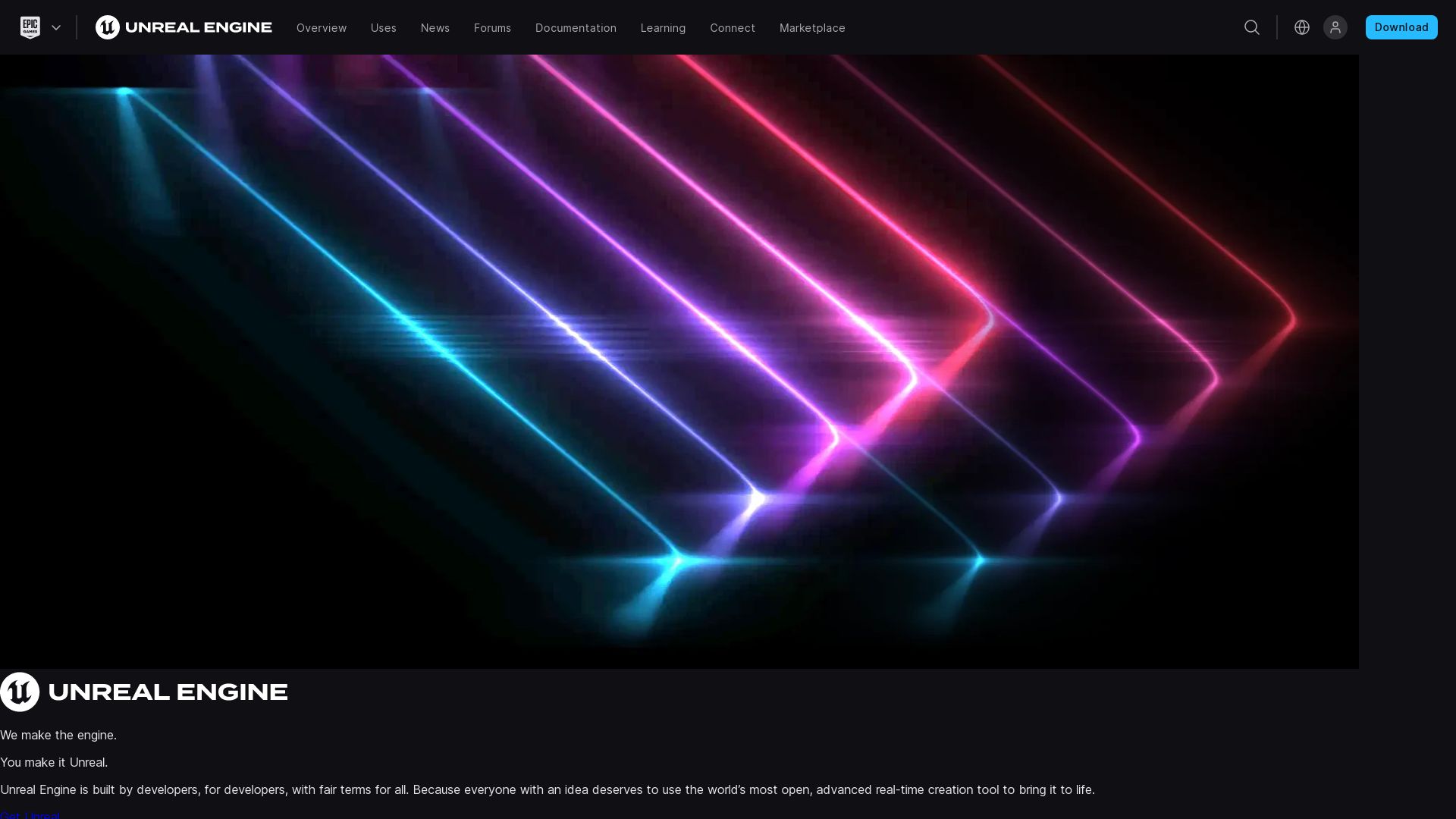
Known for powering some of the world’s most popular games, Unreal Engine carved its space in the 3D computer graphics landscape since its arrival with Unreal in 1998. Developed by Epic Games, it transcended boundaries to cater beyond first-person shooters and PCs, expanding its reach to various game genres, industries and multiple platforms including desktop, mobile, console and VR. The C++ based engine fosters environmental sustainability by reusing code, reducing development time, and physical resources.
Unreal Engine Best Features
- The latest release, Unreal Engine 5, offers enhanced capabilities for immersive gaming.
- It incorporates a powerful, real-time level editor, UnrealEd, to support constructive solid geometry operations.
- Unreal Engine promotes open-source environment with its mod-friendly attribute, evident in Unreal Engine 3.
- Epic’s acquisition, Quixel, enabled Unreal Engine to boast additional features.
| Feature | Benefit |
|---|---|
| Unreal Development Kit (UDK) | Released a free version of UE3’s SDK, facilitating development for iOS games and applications. |
| Unreal Engine Marketplace | Enables users to monetize their creations or utilize works from other developers, fostering a symbiotic ecosystem. |
| Educational Initiative | Unreal Engine is free for schools and universities, promoting tech literacy to pave way for green digital future. |
Unreal Engine Downsides
- Coding in Unreal Engine requires knowledge of C++, which might be difficult for beginners.
- Unreal Engine’s intensive graphics capabilities can make it heavier on resource requirements, consuming more energy.
Unreal Engine Pricing
Epic Games adopts a fair pricing model for Unreal Engine. It’s free for all users, however, for commercial users, Epic charges a 5% royalty for revenues exceeding USD 1 million. Products earning more than $3,000 per quarter are subject to a 5% fee. However, Epic waives the royalty model for games published on the Epic Games Store.
Unreal Engine Use Cases
Use case 1: Game Development
UE’s advanced features and graphical capabilities make it an excellent choice for creating visually stunning, interactive games for varied platforms.
Use case 2: Film and Television
With its ability to simulate lifelike environments and animations, Unreal Engine aids in creating high-quality CGI and special effects in film and TV production.
Use case 3: Education
Free access to UE for schools and universities catalyzes students’ learning in game development and visual effects, building a green digital future.
Tiffany Brise
Content writer @ Aircada, patiently awaiting a consumer AR headset that doesn’t suck.



